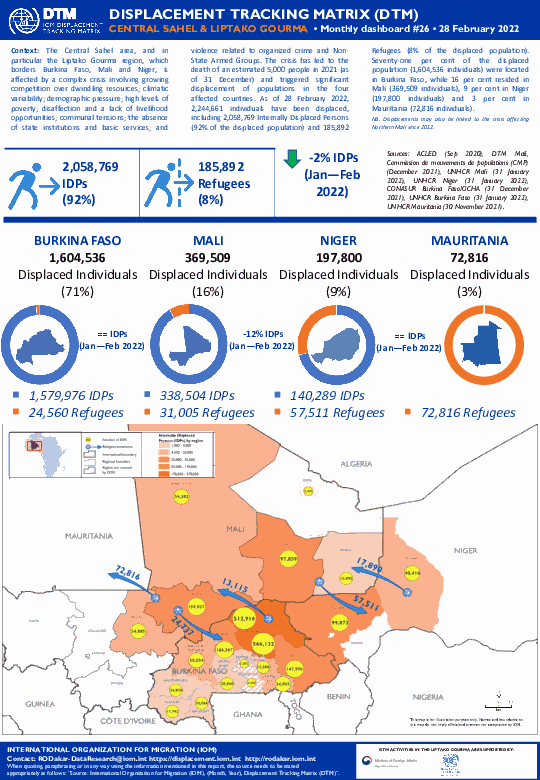-
Countries
-
Data and Analysis
-
Special Focus
-
Crisis Responses
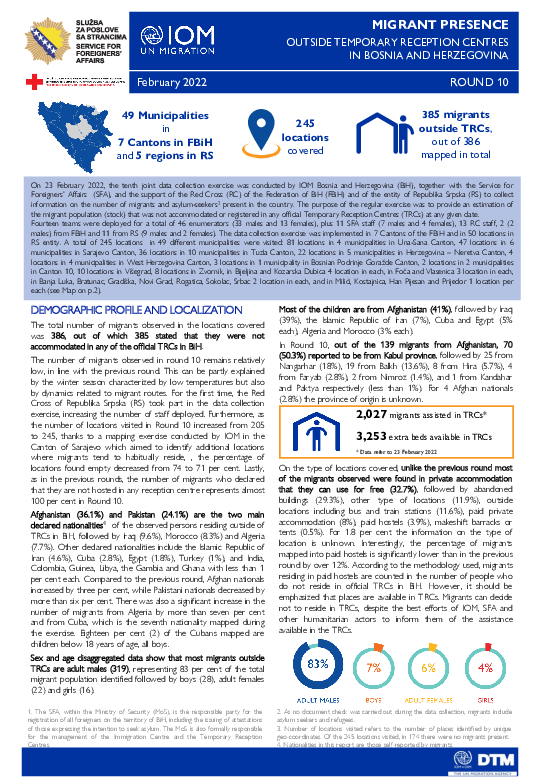
Contact
DTM Europe, DTMMediterranean@iom.int
Language
English
Location
Bosnia & Herzegovina
Snapshot Date
Feb 23 2022
Activity
- Migrants presence
- Mobility Tracking
On 23 February 2022, the tenth joint data collection exercise was conducted by IOM Bosnia and Herzegovina (BiH), together with the Service for Foreigners’ Affairs (SFA), and the support of the Red Cross (RC) of the Federation of BiH (FBiH) and of the entity of Republika Srpska (RS) to collect information on the number of migrants and asylum-seekers2 present in the country. The purpose of the regular exercise was to provide an estimation of the migrant population (stock) that was not accommodated or registered in any official Temporary Reception Centres (TRCs) at any given date.
Fourteen teams were deployed for a total of 46 enumerators (33 males and 13 females), plus 11 SFA staff (7 males and 4 females), 13 RC staff, 2 (2 males) from FBiH and 11 from RS (9 males and 2 females). The data collection exercise was implemented in 7 Cantons of the FBiH and in 50 locations in RS entity. A total of 245 locations in 49 different municipalities were visited: 81 locations in 4 municipalities in Una-Sana Canton, 47 locations in 6 municipalities in Sarajevo Canton, 36 locations in 10 municipalities in Tuzla Canton, 22 locations in 5 municipalities in Herzegovina – Neretva Canton, 4 locations in 4 municipalities in West Herzegovina Canton, 3 locations in 1 municipality in Bosnian Podrinje Goražde Canton, 2 locations in 2 municipalities
in Canton 10, 10 locations in Višegrad, 8 locations in Zvornik, in Bijeljina and Kozarska Dubica 4 location in each, in Foča and Vlasenica 3 location in each, in Banja Luka, Bratunac, Gradiška, Novi Grad, Rogatica, Sokolac, Srbac 2 location in each, and in Milići, Kostajnica, Han Pijesan and Prijedor 1 location per each.

Contact
DTM South Sudan, SouthSudanDTM@iom.int
Language
English
Location
South Sudan
Period Covered
Aug 01 2020
Dec 31 2020
Activity
- Survey
During the second half of 2020, the International Organization for Migration’s Displacement Tracking Matrix (IOM DTM) and the World Food Programme’s Vulnerability Analysis and Mapping (WFP VAM) units undertook a joint household-level assessment of Juba’s urban area and Juba IDP Camps I and III, Wau’s urban area and Naivasha Internally Displaced Persons (IDP) Camp, the urban area of Bentiu / Rubkona and Bentiu IDP Camp, and Malakal’s urban area and Malakal Protection of Civilians (PoC) site. These profiles quantify the prevalence of vulnerabilities and humanitarian needs across sectors, generate a better understanding of urban displacement and migration, including return and relocation after displacement in South Sudan or abroad, and evaluate the impact of the COVID-19 pandemic and related restrictions.
The assessment contributed to the extended Food Security and Nutrition Monitoring System (FSNMS+) initiative – endorsed by the Humanitarian Country Team (HCT) – to pilot a household-level multi-sector needs assessment for South Sudan. By expanding FSNMS coverage to key urban areas and IDP camps, the assessment addressed a long-standing information gap for the humanitarian response. Moreover, during this exercise, IOM updated the urban sampling frame developed in collaboration with the National Bureau of Statistics (NBS) using satellite imagery and field mapping. The study collected a representative sample of 1,770 households in urban areas and 1,642 households in IDP sites.

Contact
DTM Ethiopia, SLOAddisAbabaDTM@iom.int
Language
English
Location
Ethiopia
Period Covered
Jan 01 2022
Jan 31 2022
Activity
- Flow Monitoring
In January 2022, a total of 19,525 movements were observed across five of Ethiopia's flow monitoring points (FMPs). It should be noted that data collection at Humera Flow Monitoring Point in Tigray region did not take place due to security and access constraints, thus affecting the total number of movements for the month. This represents an 8% increase in daily average movements in comparison with December 2022 when an average of 582 movements per day were observed.
Outgoing movements during January have continued to be higher (85.3%) than incoming movements (14.7%). A total of 16,652 outgoing movements were observed of which 7,291 (43.8%) were heading towards Saudi Arabia, 2,668 (16.0%) were going to Kenya, 2,637 (15.8%) were travelling towards Djibouti, 940 (5.6%) to South Africa, 762 (4.6%) intended to reach Somalia and 513 (3.1%) headed to the United Arab Emirates while remaining movements were travelling to several Middle Eastern, European and North American countries.
At the same time, 2,873 incoming movements were observed, of which 1,040 (36.2%) had originated from Djibouti, while 765 (26.6%) came from Kenya, 626 (21.8%) from Sudan, 377 (13.1%) movements from Somalia, 62 (2.2%) from Yemen and the remaining from Saudi Arabia and South Sudan. Almost all of these were Ethiopian nationals who were likely returning home.
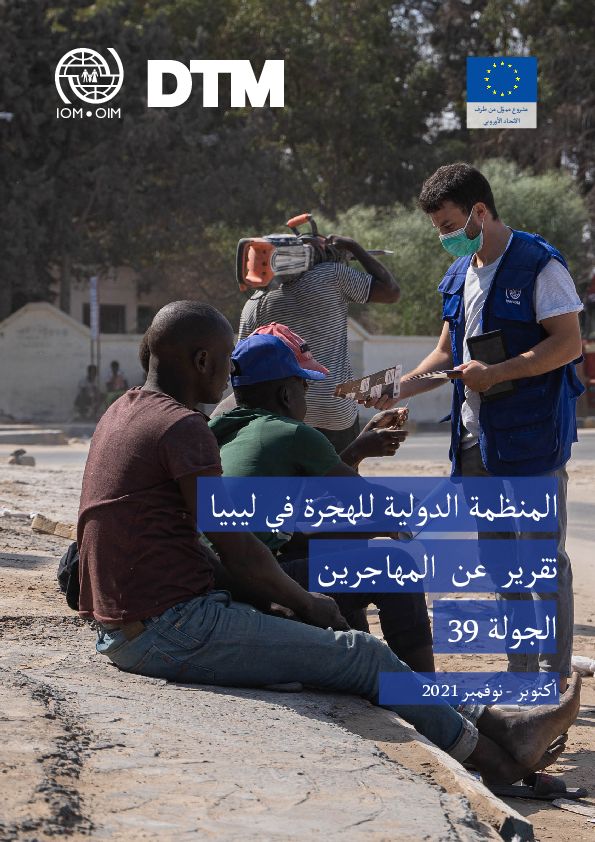
Contact
DTM Libya, DTMLibya@iom.int
Language
Arabic
Location
Libya
Period Covered
Oct 01 2021
Nov 30 2021
Activity
- Mobility Tracking
- Baseline Assessment
في إطار الجولة 39 من تجميع البيانات على مدى شهري أكتوبر ونوفمبر من سنة 2021، أحصت مصفوفة تتبع النزوح وجود إجمالي 621.007 مهاجرا في 100 بلدية في ليبيا ينحدر أصلهم من أكثر من 43 جنسية. استمرّ عدد المهاجرين في الارتفاع خلال الفترة المشمولة بالتقرير على نفس منوال النّسق الذي بدأ في مطلع سنة 2021. غير أنّ عدد المهاجرين في ليبيا لا يزال أدنى قليلا من العدد المسجّل في سنة 2019 بالنسبة إلى نفس فترة الدراسة (645.081 مهاجر خلال الجولة 28). وفي سنة 2020 ، انخفض عدد المهاجرين في ليبيا على إثر بداية وباء كوفيد 19 والتباطؤ الاقتصادي وتشديد المراقبة الأمنية علاوة على التقييدات المفروضة على التنقّل.
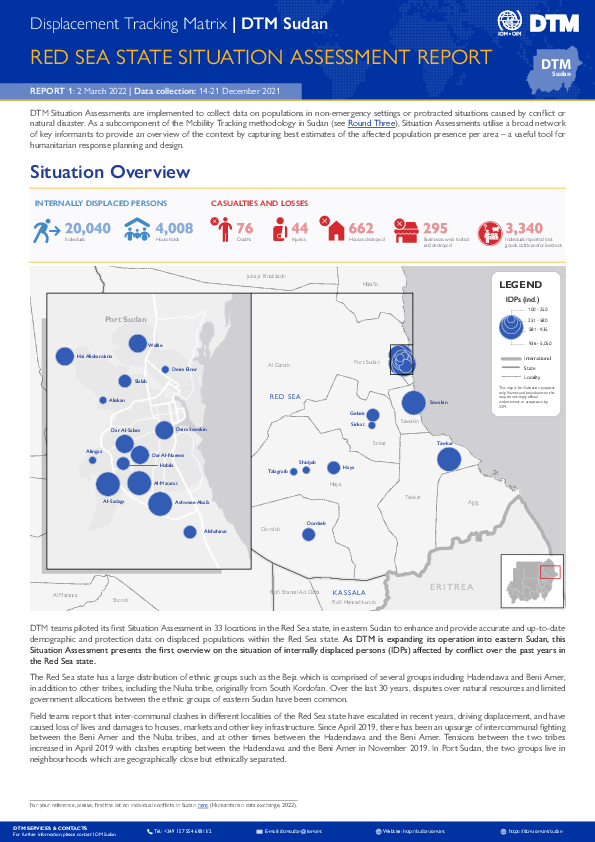
Contact
DTM Sudan; dtmsudan@iom.int
Language
English
Location
Sudan
Period Covered
Dec 14 2021
Dec 21 2021
Activity
- Mobility Tracking
DTM teams piloted its first Situation Assessment in the Red Sea state in 33 locations to enhance and provide accurate and up-to-date demographic and protection data on displaced populations within the Red Sea state. As DTM is expanding its operation into eastern Sudan, this Situation Assessment presents the first overview on the situation of internally displaced persons (IDPs) affected by conflicts in the Red Sea state over the past years.
DTM Situation Assessments are implemented to collect data on populations in non-emergency settings or protracted situations caused by conflict or natural disaster. As a subcomponent of the Mobility Tracking methodology in Sudan (see Round Three), Situation Assessments utilise a broad network of key informants to provide an overview of the context by capturing best estimates of the affected population presence per area – a useful tool for humanitarian response planning and design.
The Central Sahel area, and in particular the Liptako Gourma region, which borders Burkina Faso, Mali and Niger, is affected by a complex crisis involving growing competition over dwindling resources; climatic variability; demographic pressure; high levels of poverty; disaffection and a lack of livelihood opportunities; communal tensions; the absence of state institutions and basic services; and violence related to organized crime and Non-State Armed Groups. The crisis has led to the death of an estimated 5,000 people in 2021 (as of 31 December) and triggered significant displacement of populations in the four affected countries. As of 28 February 2022, 2,244,661 individuals have been displaced, including 2,058,769 Internally Displaced Persons (92% of the displaced population) and 185,892 Refugees (8% of the displaced population). Seventy-one per cent of the displaced population (1,604,536 individuals) were located in Burkina Faso, while 16 per cent resided in Mali (369,509 individuals), 9 per cent in Niger (197,800 individuals) and 3 per cent in Mauritania (72,816 individuals).

Contact
DTM Ethiopia, SLOAddisAbabaDTM@iom.int
Language
English
Location
Ethiopia
Period Covered
Jan 01 2021
Dec 31 2021
Activity
- Site Assessment
- Mobility Tracking
- Village Assessment
The Mobility Overview 2021 report details significant movements within the country and a national overview of displacement and returns, which mainly draws from DTM’s Site Assessment, Emergency Site Assessment, Village Assessment Survey and an extensive national network of key informants.
As of September 2021, displacement was estimated at 4.23 million internally displaced persons (IDPs) throughout Ethiopia. With the outbreak of the Northern Ethiopia Crisis, the Emergency Site Assessment round 8 estimated that there were 2.11 million IDPs displaced due to the Northern Ethiopia Crisis in August 2021 – 1.8 million IDPs displaced in Tigray, 151,040 IDPs in Amhara and 149,329 IDPs in Afar regions. In the second half of 2021, armed conflict moved further down south which resulted in an increase in the number of IDPs in Amhara and Afar regions which is estimated by key informants to have reached around 1.4 million IDPs and 470,000 IDPs respectively at the peak of displacement in early December 2021. Nevertheless, by the end of December 2021, mass returns were taking place in Amhara region. Displacement in the rest of Ethiopia is estimated at 2.12 million IDPs, according to Site Assessment round 27 which took place in August and September 2021. The primary cause of displacement was conflict in 1,160 sites (74%), and the primary reason IDPs were unable to return was that their houses were either damaged or destroyed (1,138 sites, 72%). In addition to conflict, climate induced displacement (droughts, flash floods and seasonal floods) were the primary cause of displacement in 353 sites (22%).
Regarding returns, DTM identified 1.5 million returning IDPs as of Village Assessment Survey round 10 in August and September 2021. A large number of returning IDPs were concentrated in Dawa zone, Somali region and were first identified through round 9 of the Village Assessment Survey when they began to return following the dry season to reconstruct homes that were damaged and in West Guji zone, Oromia region, following the Gedeo-West Guji Crisis in 2018. It is estimated that there have been significant returns in Tigray region as well but this could not be verified in person due to resource constraints and other operational challenges.

Contact
DTM South Sudan, SouthSudanDTM@iom.int
Language
English
Location
South Sudan
Period Covered
Jan 01 2022
Jan 31 2022
Activity
- Site Assessment
- Registration
- Flow Monitoring
- Mobility Tracking
In January 2022, the monthly population count was conducted at Masna Collective Centre where 3,025 individuals / 696 households were identified and Naivasha IDP Camp where 7,885 individuals / 2,146 households were counted. The population of Naivasha IDP Camp increased by 120 compared to December 2021.

Contact
DTM South Sudan, SouthSudanDTM@iom.int
Language
English
Location
South Sudan
Period Covered
Dec 01 2021
Dec 31 2021
Activity
- Site Assessment
- Registration
- Flow Monitoring
- Mobility Tracking
In December 2021, the monthly population count was conducted at Masna Collective Centre where 3,006 individuals / 684 households were identified and Naivasha IDP Camp where 7,765 individuals / 1,981 households were counted. The population of Naivasha IDP Camp decreased by 959 individuals as compared to November 2021.
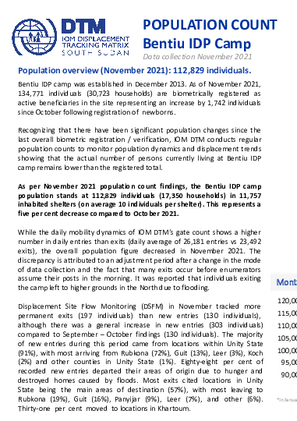
Contact
DTM South Sudan, SouthSudanDTM@iom.int
Language
English
Location
South Sudan
Period Covered
Nov 01 2021
Nov 30 2021
Activity
- Site Assessment
- Registration
- Flow Monitoring
- Mobility Tracking
Bentiu IDP camp was established in December 2013. As of November 2021, 134,771 individuals (30,723 households) are biometrically registered as active beneficiaries in the site representing an increase by 1,742 individuals since October following registration of newborns. Recognizing that there have been significant population changes since the last overall biometric registration / verification, IOM DTM conducts regular population counts to monitor population dynamics and displacement trends showing that the actual number of persons currently living at Bentiu IDP camp remains lower than the registered total.
